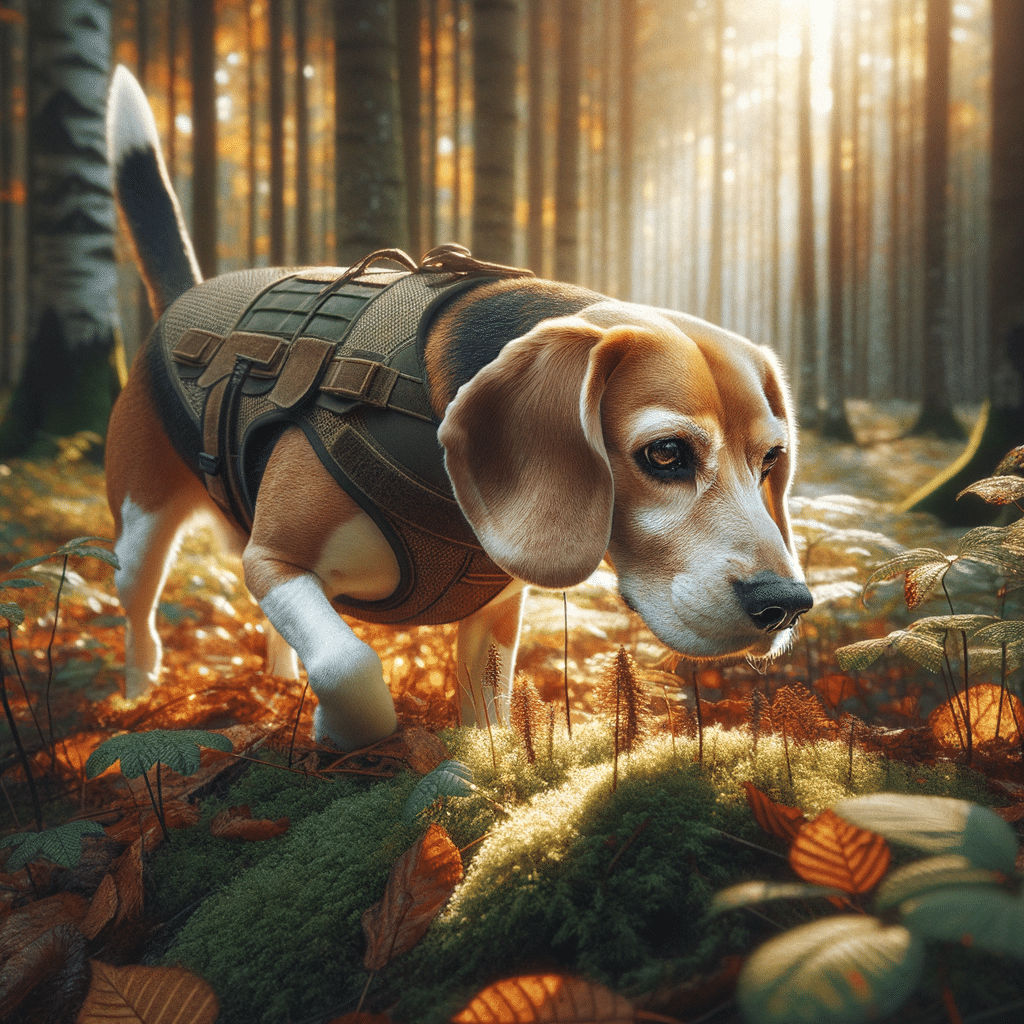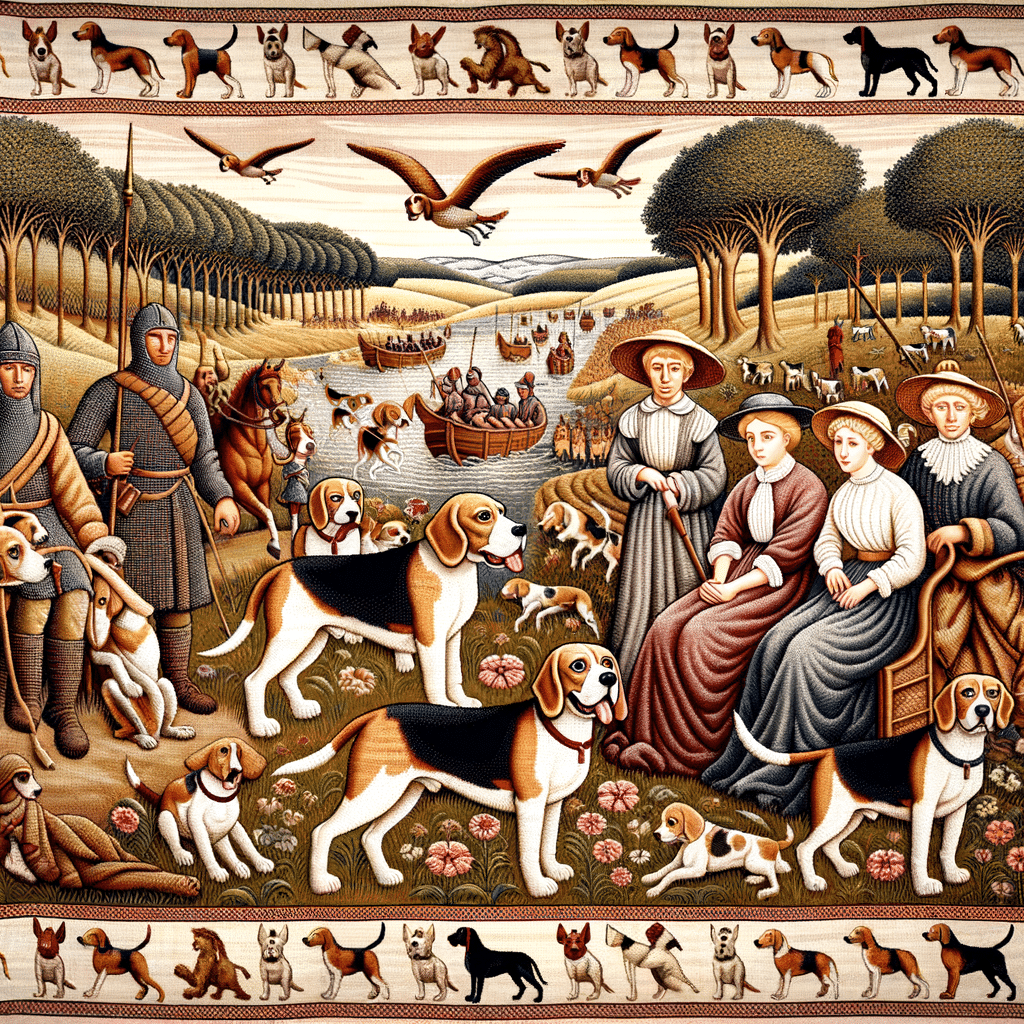The beagle breed has a long history of hunting alongside humans. Beagles are known for their sharp sense of smell and tracking ability, helping hunters by tracking and trapping game for centuries.
In This Article
Initially bred for hunting, beagles’ instinct and design make them particularly good at hunting small—to medium-sized game. They show agility, a keen nose, and a size suitable for various hunting scenarios.
In hunting, beagles typically pursue smaller animals like rabbits and hares. Their small bodies allow them to navigate areas with thick underbrush, a typical habitat for their prey. This dog breed’s strong sense of smell enables them to follow trails over different terrains.
Additionally, beagles often hunt in packs, using their collective ability to outmaneuver and effectively catch their prey. While commonly associated with rabbit hunting, their versatility allows them to adapt to hunting other small game with the proper training and guidance.
Highlights
Beagles excel at hunting due to their strong sense of smell and agility.
Hunting with beagles typically involves tracking small game such as rabbits and hares.
Beagles can hunt in various environments, usually in packs, to locate and capture prey.
Beagle Breeds and Characteristics
The beagle is celebrated for its hunting ability and sense of smell. This section details the beagle’s physical attributes, temperament, classification standards, and historical hunting role.
Physical Traits and Senses
Beagles are compact dogs, typically between 13 and 15 inches at the shoulder. They have a muscular build suited for stamina and agility. They have a keen sense of smell and are among the best dog breeds for hunting. Their large, floppy ears help direct scents towards their nose. This heightened sense of smell makes them excellent at tracking a scent trail over long distances.
Beagle Temperament and Behavior
Known for their determination and friendly nature, beagles are affectionate and energetic. They use a distinctive bark, bay, or howl to communicate during hunts. Their friendliness makes them both beloved family pets and terrific hunting companion dogs.
Beagle Standard and Classification
The American Kennel Club recognizes two varieties of beagles based on size. Both are under 15 inches. These dogs are categorized within the hound group in the United States and similar classifications in Great Britain. In show standards, they are judged on traits such as body structure, gait, and coat texture, which are also factors that historically contributed to their effectiveness in rabbit hunting.
History of Beagles in Hunting
Originating in Great Britain, the ancestry of beagles can be traced back to foxhounds and other hunting dogs. Initially bred by fox hunters, they were designed to hunt in packs or pairs (or braces) to track small game, mainly rabbits and hares. The beagle’s history with English foxhunting shows their role as a hunter’s right hand, with their masters relying on their acute sense of smell and stamina to pursue game.
Training and Hunting Practices
Training beagles for hunting requires developing their instincts and taking advantage of their in-built skills and abilities. Their exceptional sense of smell and tendency to track scents are at the core of this training process.
Training Techniques for Hunting
To begin training a beagle for hunting, they must first master basic obedience. This foundational step ensures that they follow commands, crucial for safety and effectiveness in the field. Training techniques often include:
Positive reinforcement: Offering rewards for correct behavior encourages learning and strengthens the bond between dog and owner.
Scent exposure: By gradually introducing the dog to game scents, they learn to associate specific smells with the hunting task.
Mock trails: Creating mock scent trails can sharpen a beagle’s tracking skills and prepare them for real hunting scenarios.
Consistency in practice is essential because frequent training sharpens the dog’s abilities and enhances its hunting skills.
Beagles in the Field
Beagles showcase their endurance and talent for pursuing game when in the field. These dogs are natural hunters, thanks to their:
Stamina: Beagles require frequent physical conditioning to maintain the endurance needed for long hunts.
Sense of smell: Their powerful noses detect game from a distance, guiding their pursuit.
Tracking ability: They methodically follow scent trails, often running fast but paying careful attention to the scent’s direction.
Common practices during hunts include allowing the beagle to work slightly ahead of the dog owner. This allows the hunter to take full advantage of their hunting companion’s tracking abilities. The dogs typically vocalize when they find a trail, and you must understand these cues to hunt effectively with your beagle.
Common Prey and Hunting Environments
Beagles excel in hunting various small game, primarily due to their keen sense of smell and stamina. They are traditionally used in packs for hunting, primarily within varied terrains that challenge hunter and hound.
Types of Game Beagles Hunt
Beagles have a rich history in hunting, primarily focusing on rabbits and hares, their most common prey. However, their versatility as hunting companions extends to tracking and flushing out other small game, such as birds and squirrels.
Occasionally, beagles have been known to hunt larger prey, including deer, bobcats, and wild boar.
Notably, in the cases of larger game like deer and wild boar, beagles typically help with tracking and flushing the animal rather than directly confronting it.
Beagling and Hunting Terrain
Beagling, the practice of hunting with beagles, is a sport with deep roots in Great Britain and the United States. Experienced hunters typically hunt with a pack of around ten beagles. The most common terrains for beagling include:
Open fields
Dense thickets
Woodlands
These environments provide the ideal conditions for beagles to exercise their tracking abilities. The varied landscapes of Great Britain and the United States offer many opportunities for beagles to chase and hunt their prey, exercising their natural determination and endurance.
Frequently Asked Questions
This section answers commonly asked questions about hunting with beagles.
What types of prey are beagles traditionally trained to hunt?
Beagles are traditionally trained to hunt various small game, usually rabbits. They are especially skilled at trailing and hunting rabbits, including the eastern cottontail and the snowshoe hare.
How do beagles’ hunting abilities compare when hunting different small animals?
Beagles show strong hunting abilities across the board; however, their compact size and agility make them particularly effective in hunting smaller animals, such as rabbits and hares, where they can maneuver through dense underbrush.
Are beagles typically used in bird hunting?
Beagles are not commonly used in bird hunting as their skill set is optimized for ground-scenting small game, unlike pointer and retriever breeds, which are used for bird hunting.
What is the difference between a hunting beagle and a show beagle?
A hunting beagle is primarily bred for fieldwork. The hunting beagle develops traits useful for hunting, such as stamina, a keen nose, and a loud bark. Show beagles are bred to meet specific physical beauty standards set by kennel clubs for competitions.
Is the beagle breed known for having a strong hunting instinct?
The beagle breed is known for its strong hunting instinct, which can be seen even in beagles not actively trained for hunting. This instinct reveals itself through a natural tendency to track scents and pursue small game.
How does the beagle’s prey drive compare to other hunting dog breeds?
Beagles have a high prey drive compared to many other breeds, though this drive is specialized for scent work and tracking rather than retrieval or pointing. They are relentless trackers, often outperforming other breeds in their ability to follow complex scent trails.






